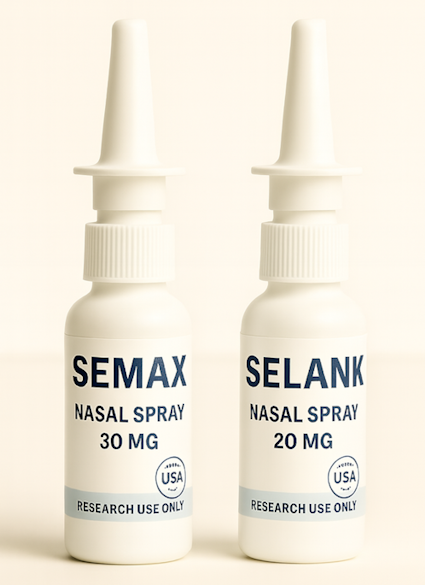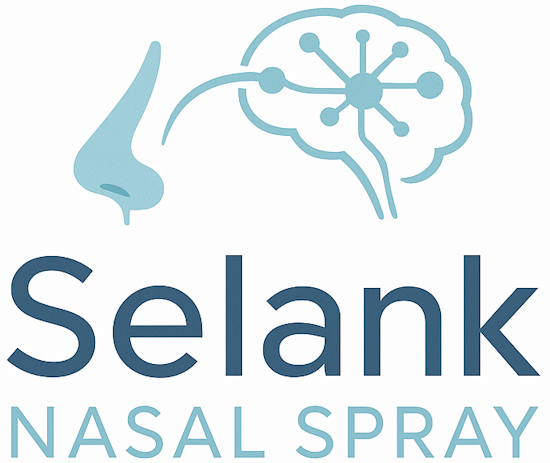Selank Nasal Spray: The Ultimate Guide for 2025
Selank is a research peptide that has drawn significant interest for its potential roles in mood, stress, and cognition. Developed as a synthetic analog of tuftsin, this peptide has been studied in Russia and internationally for putative anxiolytic activity, possible effects on neurotransmitter systems, and immune modulation. This guide explains what selank nasal spray is, how intranasal delivery works, what the literature suggests about benefits and safety, and where to go next if you want deeper, research-focused detail.
What Is Selank Nasal Spray?

This peptide is an intranasal formulation of the synthetic peptide Selank, which is derived from the immune peptide tuftsin. The nasal spray route delivers small molecules and peptides across the nasal mucosa and, via olfactory and trigeminal pathways, toward the central nervous system, reducing first-pass metabolism in the gut and liver. In research contexts, nasal administration of this peptide is valued for convenience, rapid onset, and reproducibility within structured protocols.
Key points researchers often focus on:
- Intranasal absorption can support timely central exposure compared with oral routes.
- It has been explored for effects related to anxiety, memory, and attention, with an emphasis on non-sedating profiles in early literature.
- Because it is a research compound, oversight by a qualified healthcare professional is recommended in clinical-style studies.
For a deeper, methods-oriented discussion of titration and weight-based ranges, see our dedicated Selank nasal spray dosage guide.
How Selank May Work in the Brain & Body
Preclinical and limited clinical data suggest that Selank interfaces with multiple neurotransmitter systems involved in stress and cognition. Put simply, the compound is being investigated for how it might influence inhibitory signaling and neural plasticity—two pillars of emotional regulation and cognitive function.
- GABAergic modulation: Several reports propose that this peptide indirectly augments inhibitory tone, consistent with findings in anxiety models where it reduces anxiety without overt sedation.
- Monoaminergic balance: Exploratory work has examined serotonergic and dopaminergic pathways that underlie motivation, mood, and focus.
- Neurotrophic support: Some studies discuss downstream signals that may relate to synaptic plasticity and memory consolidation.
- Immunomodulation: Because of its tuftsin lineage, this peptide is also studied for potential effects on cytokines and immune responses, which are frequently perturbed during chronic stress.
Importantly, these proposed mechanisms remain an active area of investigation. The compound is not approved to diagnose, treat, or cure disease; rather, it is used to generate hypotheses that future trials can test.
Potential Research-Backed Areas of Interest
Across preclinical models and small human studies, investigators have explored several domains that are relevant to mental performance and overall well being:
1) Anxiety & Stress Reactivity
Selank appears in literature as a candidate for non-sedating, anti anxiety support. In some reports, subjects demonstrate calmer affect and steadier attention under stressors. Exploratory data in generalized anxiety disorder have been referenced in regional publications, though larger, modern randomized studies are still needed.
2) Attention, Working Memory & Mental Efficiency
By dampening stress interference and potentially supporting plasticity, this compound is being studied for effects on memory, executive control, and mental clarity. In practical terms, research participants often describe “clearer headspace” and easier recall across learning processes—observations that future controlled work must quantify.
3) Mood Regulation
Because chronic stress is tightly linked to depression-like states and mood volatility, Selank’s putative contribution to mood stabilization is of interest. Preliminary and anecdotal reports discuss fewer stress-linked symptoms (e.g., rumination), with maintained alertness. That “calm without cloudiness” theme is common in early narratives.
4) Metabolic-Stress Interface
Chronic stress can worsen glycemic control and body-composition risk factors. Some investigators are exploring whether stress modulation and immune-neuro crosstalk have downstream relevance for metabolic syndrome. Any such connections remain exploratory, but they align with the broader “inflammation and brain” research thread. Emerging papers also discuss how sleep, inflammation, and stress loops might feed into metabolic syndrome trajectories that degrade cognitive performance and well being.
For a domain-by-domain look at proposed advantages (skinny on mechanisms, thick on citations), see Selank benefits.
Intranasal Use, Dosing Concepts & Study Designs
In intranasal paradigms, investigators typically start with conservative exposure and escalate if needed, while documenting endpoints like state anxiety, working memory, and vigilance. Because nasal spray delivery can produce relatively swift pharmacodynamic signals, designs often include pre- and post-task assessments after a single dose and again after multi-day exposure.
- Design basics: Weight-stratified cohorts; standardized nasal spray devices; validated mood/cognition scales; and pre-registered outcomes help improve data quality.
- Timing: With intranasal routes, research teams often measure within 30–90 minutes of administration, then track daily changes across weeks.
- Controls: Placebo comparators and blinding remain critical to isolate true cognitive enhancing effects from expectancy.
For protocol scaffolding, weight tables, and practical intranasal considerations, head to Selank nasal spray dosage. If you’re co-examining synergy with other peptides used intranasally, review the combined protocol notes in Selank & Semax nasal spray.
Safety Signals, Side Effects & Open Questions
Across published reports and lab experience, intranasal Selank has generally been described as well-tolerated. The most common events are local and mild (transient dryness, tickle, or irritation) related to the nasal spray vehicle. Systemic effects have been limited in short-duration paradigms, though anyone designing human-facing research should maintain appropriate screening and monitoring.
- Local tolerability: Monitor mucosa for dryness or irritation; rotate nostrils; ensure device hygiene.
- Systemic observations: Track mood, anxiety, sleep, and symptoms of GI or neurological discomfort in logs. Some reports mention subtle shifts in activation during the first days that settle with steady schedules.
- Unknowns: Longer-term exposure windows, interactions with concurrent agents, and outcomes in populations with comorbid depression or cardiometabolic risk remain under-characterized. Conservative designs and medical oversight are prudent.
If your team needs an overview of procurement considerations for lab-grade materials, see our neutral buyer’s companion: Buy Selank peptide online (research use).
Selank vs. Semax & Combination Research

Semax is another intranasal neuropeptide with a complementary profile—often framed as “drive and plasticity”—while selank nasal is framed as “calm clarity.” Comparative discussions typically emphasize:
- Selank: Investigated for non-sedating calming, steadier attention, and stress buffering that can indirectly support memory and task performance.
- Semax: Investigated for direct attention/learning tone and BDNF-linked plasticity pathways.
For a point-by-point comparison including intranasal paradigms, see Selank vs Semax. For researchers exploring co-administration sequences, see the protocol notes in Selank & Semax nasal spray.
Frequently Asked Questions
What does selank nasal spray do in research settings?
Teams most often evaluate endpoints related to anxiety ratings, attention/working memory, and mental clarity. Early literature suggests a non-sedating calming effect that can reduce interference from stress and may help preserve performance across learning processes.
How fast does an intranasal session act?
With a well-metered nasal spray, many protocols record early signals within 30–60 minutes. That said, some outcomes (e.g., mood steadiness) are best captured over multi-day windows. Our dosage overview discusses acute vs. repeated exposure patterns for selank nasal designs: Selank nasal spray dosage.
Is this peptide being explored for diagnosed anxiety?
Historical publications reference cohorts with generalized anxiety disorder, but rigorous modern trials are limited. Research remains exploratory, and anyone pursuing clinical-style work should partner with a licensed healthcare professional and appropriate IRB/ethics processes.
Could Selank matter for metabolic syndrome research?
Indirectly—by buffering stress loops that worsen inflammation and sleep, which can influence metabolic syndrome. This is a developing area and not a proven indication. Still, it’s why some investigators track waist, sleep quality, and glycemic proxies alongside mood and cognitive function in longitudinal designs related to metabolic syndrome.
Does Selank make you drowsy?
Early literature and user diaries generally describe “calm alertness,” not sedation. That profile—calmer affect with preserved focus—is part of why Selank is discussed as potentially cognitive enhancing in stressful contexts and why some teams note better day-to-day well being and overall well being when schedules are consistent.
Where should I start if I’m mapping a study?
Begin with a clear endpoint hierarchy (state anxiety, verbal memory, vigilance), a conservative titration plan, and robust placebo controls. Our dosage explainer and combination page provide scaffolds:
- Selank nasal spray dosage
- Selank & Semax nasal spray
- Selank vs Semax
- Selank benefits
- Buy Selank peptide online (research use)
Bottom Line
Selank nasal spray research sits at the intersection of stress biology and performance science. As a synthetic analog of tuftsin delivered via nasal spray, it is being explored for steadying affect, preserving task engagement, supporting memory, and smoothing stress-linked symptoms—while keeping subjects alert. Although data sets remain modest, the intranasal route, tolerability profile, and plausible mechanisms justify continued hypothesis-driven work. With careful designs, appropriate controls, and medical oversight, investigators can better determine where this peptide belongs among modern tools aimed at protecting overall well being in high-stress environments.
Selected References (Open-Access & Reviews)
- Sudakov K, et al. “Tuftsin analogs and central effects.” Cell Tissue Res. (background on tuftsin lineage)
- Inozemtseva L, et al. “Selank and GABAergic modulation.” Neurosci Behav Physiol; see discussion of allosteric effects.
- Ivashchenko DV, et al. “Anxiolytic properties of Selank.” Acta Naturae / PMC5322660.
- Ashmarin I, et al. “Gene expression shifts after intranasal peptides.” PMC4757669.
- Zozulya AA, et al. “Selank and anxiety models.” Neurosci Behav Physiol / PubMed 18454096.
- Barsegyan A, et al. “Stress, memory, and immune crosstalk: conceptual overview.” (immune-neuro links relevant to immune responses and metabolic syndrome frameworks)
Further Reading on This Site
- Selank nasal spray dosage — weight-aware ranges, timing, and study scaffolds.
- Selank benefits — domain-by-domain survey with citations.
- Selank & Semax nasal spray — combination rationale and scheduling concepts.
- Selank vs Semax — side-by-side mechanisms and use-case contrasts.
- Buy Selank peptide online — neutral overview of sourcing for research use.
